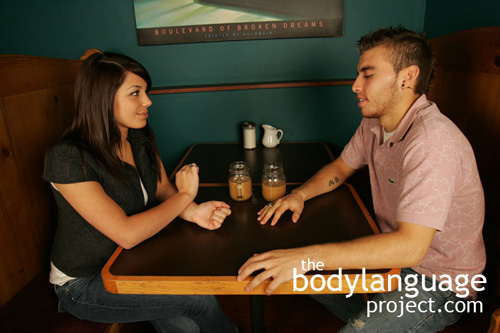Body Language of Short Grabber Handshake or Finger Grabber Handshake
Synonym(s): Finger Grabber Handshake.
Description: A handshake whereby only the fingers make it into the hand. Because the grip ends up short, the fingers are usually sandwiched together painfully.
In One Sentence: The finger grabber aims to cause pain and inflict dominance and aggression over others.
How To Use it: Use this handshake when you wish to intimidate other people. This can be useful in threatening competitors. This can be useful to set people straight when they are causing you problems or are encroaching on your territory. The handshake is best served to those you feel are not prepared to back up their stake of dominance over you.
Context: Business.
Verbal Translation: “I’m so insecure, but pretending to be dominant, that I’m going to put you through the ringer by grabbing your finger tips and squishing up your fingers to cause you pain.”
Variant: See Country Handshake (The), Cold Dead Wet Fish Handshake, Double Gripper Politician Handshake or Double Hander (The), Short Grabber/Finger Grabber Handshake, Oddball Handshake, Palm Up, Palm Down and Palm Even Handshakes, Stiff Arm And Thrust Forward Handshake, Death Grip Handshake, Wrench Forward Handshake, Undershaker Handshake, Wrist Hold Handshake, Wrist Hold Handshake and Upper Arm Grip Handshake, Limp Fish Handshake, Teacup Handshake, Arm Twister Handshake (The), Firm handshake, Fist Bumping.
Cue In Action: James was a routine pranker. The family reunion was no exception. It was widely known that one should avoid shaking hands with him as he frequently caused his cousins and nephews to squeal in pain by crushing their finger tips.
Meaning and/or Motivation: Someone that grabs your fingers rather than your entire hand is trying to keep you at a distance and also put you in your place. Short grabbers are usually insecure but often try to hide this by coming off as dominant through the infliction of pain and the denial of proper, though measured, intimacy which the handshake is designed to create. If they add a crushing action in addition to the finger tip grab they are trying to send and even stronger message by displaying their physical power over you.
Crushing is used to put a bit of fear into their partners so as to dismiss the likelihood of any future challenge against them. In other words, the short grabber is messing around with the handshake on purpose and trying to put another person through the ringer, so to speak.
When the handshake comes up short by accident, rather than on purpose, the other person will let up and apply less pressure or readjust so as to do a proper handshake rather than cause undo pain.
If by chance, you accidentally grab the fingers of someone else, which can happen when men shake hands with women, you can vocally suggest doing the handshake over again. A simple “sorry, that didn’t quite work, let’s give it another go” will suffice. This will show that you are concerned about starting off on the right foot and truly wish to set the proper tone for the relationship.
Cue Cluster: The finger tip grabber is usually insecure, but tries to come off as cocky and arrogant. He will be boisterous and overstep personal space boundaries. He will touch when it’s inappropriate, slap a shoulder or ruffle hair. He is often a practical joker and tries to put people through their steps doing anything to make them feel uncomfortable.
Body Language Category: Anger body language, Arrogance or arrogant body language, Aggressive body language, Dominant body language, Hostile body language, Low confidence body language, Low confidence hand displays, Masked body language, Negative body language, Social touching.
Resources:
Aström, J ; Thorell, L H ; Holmlund, U ; D’Elia, G. Handshaking, personality, and psychopathology in psychiatric patients, a reliability and correlational study. Perceptual and motor skills 1993, Vol.77(3 Pt 2): 1171-86.
Bohm. 1997. Effects of interpersonal touch, degree of justification, and sex of participant on compliance with a request. The Journal of social psychology. 137: 460-469.
Chaplin William F.; Phillips Jeffrey B; Brown Jonathan D.; Clanton Nancy R.; Stein Jennifer L.; 2000. Handshaking, gender, personality, and first impressions Journal of personality and social psychology. 79(1): 110-117.
Crusco, A. and C. Wetzel. 1984. The midas touch: the effects of interpersonal touch on restaurant tipping, Personality and Social Psychology Bulletin 10: 512–517.
Debrot, Anik ; Schoebi, Dominik ; Perrez, Meinrad ; Horn, Andrea B. Touch as an interpersonal emotion regulation process in couples’ daily lives: the mediating role of psychological intimacy. Personality & social psychology bulletin. 2013. 9(10): 1373-85.
Dolcos, Sanda ; Sung, Keen ; Argo, Jennifer J ; Flor-Henry, Sophie ; Dolcos, Florin. The power of a handshake: neural correlates of evaluative judgments in observed social interactions. Journal of cognitive neuroscience. 2012 24(12): 2292-305.
Frumin, Idan; Ofer Perl; Yaara Endevelt-Shapira; Ami Eisen; Neetai Eshel; Iris Heller; Maya Shemesh; Aharon Ravia; Lee Sela; Anat Arzi and Noam Sobel. A Social Chemosignaling Function for Human Handshaking. eLife 2015. 4:e05154
DOI: http://dx.doi.org/10.7554/eLife.05154.
http://bodylanguageproject.com/articles/shake-hands-share-human-scent-curious-case-hand-sniffing-body-language/
Fisher, J; Rytting, M and Heslin, R. 1976. Hands touching hands: affective and evaluative effects on interpersonal touch, Sociometry 39: 416–421.
Ghareeb, P.A. ; Bourlai, T. ; Dutton, W. ; McClellan, W.T. Reducing pathogen transmission in a hospital setting. Handshake verses fist bump: a pilot study. Journal of Hospital Infection. 2013. 85(4): 321-323.
Guéguen, Nicolas. Nonverbal encouragement of participation in a course: the effect of touching Social Psychology of Education. 2004. 7: 89–98.
http://bodylanguageproject.com/articles/a-touching-way-to-encourage/
Gueguen, Nicolas; Sebastien Meineri and Virginie Charles-Sire. Improving Medication Adherence by Using Practitioner Nonverbal Techniques: A Field Experiment on the Effect of Touch. Journal of Behavioral Medice. 2010. 33:466–473
DOI 10.1007/s10865-010-9277-5
http://bodylanguageproject.com/articles/touching-boosts-compliance-improving-medical-compliance-using-nonverbal-communication/
Guéguen, N. (2001a). Toucher et soumission a` une requeˆte: Re´plications expe´rimentales en situation naturelle et e´valuation de l’impact du statut. Revue Internationale de Psychologie Sociale. 2001(a). 14(3):113-158.
Guéguen, N. (2001b). L’effet d’influence du toucher sur le comportement du consommateur: 2 illustrations expe´rimentales en exte´rieur. Direction et Gestion: La Revue des Sciences de Gestion. 2001(b). 190–191, 123–132.
Guéguen, N and C. Jacob 2006, Touch and consumer behavior: A new experimental evidence in a field setting, International Journal of Management 23: 24–33.
Guéguen, N., & Jacob, C. The effect of touch on tipping: An evaluation in a French’s bar. International Journal of Hospitality Management. 2005. 24(2): 295-299.
Gueguen, Nicolas; Celine Jacob; Gaelle Boulbry. The Effect of Touch on Compliance With a Restaurant’s Employee Suggestion. Hospitality Management. 2007. 26: 1019-1023.
http://bodylanguageproject.com/articles/touching-leads-compliance-study/
Gueguen, Nicolas. Handshaking and Compliance With a Request – A Door-to-door Setting. Social Behavior and Personality. 2013. 41(10): 1585-1588.
http://bodylanguageproject.com/articles/handshakes-lead-compliance-study/
Greenbaum, Paul ; Rosenfeld, Howard. Varieties of touching in greetings: Sequential structure and sex-related differences. Journal of Nonverbal Behavior. 1980. 5(1): 13-25.
Hiemstra, Kathleen M. Shake My Hand: Making the Right First Impression in Business With Nonverbal Communications.(Brief Article)(Statistical Data Included). Business Communication Quarterly. 1999. 62(4): 71.
Hertenstein, Matthew J; Keltner, Dacher; App, Betsy; Bulleit, Brittany A; Jaskolka, Ariane R 2006. Touch Communicates Distinct Emotions. Emotion. 6(3): 528-533
Hareli, Shlomo; Noga Shomrat and Ursula Hess. Emotional Versus Neutral Expressions and Perceptions of Social Dominance and Submissiveness. Emotion. 2009 9(3): 378-384. DOI: 10.1037/a0015958
http://bodylanguageproject.com/articles/dominance-expression-conveyed-different-facial-expressions-men-women/
Jeffrey D. Fisher; Marvin Rytting; Richard Heslin. 1976. Hands Touching Hands: Affective and Evaluative Effects of an Interpersonal Touch. Sociometry, 39(4): 416-421.
Lynn et al., 1998 M. Lynn, J.M. Le and D. Sherwyn. 1998. Reach out and touch your customers, Cornell Hotel and Restaurant Administration Quaterly 39: 60-65.
Lipsitz, Rebecca (2000). “A Gripping Start.” In Scientific American (September), p. 32.
Morris, Desmond (1994). Bodytalk: The Meaning of Human Gestures (New York: Crown Publishers).
Pease, Barbara and Allan Pease. 2006. The Definitive Book of Body Language Hardcover. Bantam.
Smith, D. E., Gier, J. A., & Willis, F. N. 1982. Interpersonal touch and compliance with a marketing request. Basic and Applied Social Psychology. 3: 35-38.
Sanda Dolcos; Keen Sung; Jennifer J. Argo; Sophie Flor-Henry and Florin Dolcos. The Power of a Handshake: Neural Correlates of Evaluative Judgments in Observed Social Interactions. Journal of Cognitive Neuroscience. 24; 12: 2292–2305.
http://bodylanguageproject.com/articles/handshake-open-body-language-powerful-nonverbal-effect-brain/
Schubert, Thomas W. The Power In Your Hand: Gender Differences In Bodily Feedback
From Making a Fist. Society for Personality and Social Psychology. 2004. 30(6): 757-769. DOI: 10.1177/0146167204263780
http://bodylanguageproject.com/articles/men-view-power-body-language-different-women-bodily-feedback-making-fist/
Stewart, Greg L. ; Dustin, Susan L. ; Barrick, Murray R. ; Darnold, Todd C. Zedeck, Sheldon (editor). Exploring the Handshake in Employment Interviews. Journal of Applied Psychology. 2008. 93(5): 1139-1146.
Spezialetti, Brian D. Do’s and don’ts for winning the job interview. (laboratory technicians). Medical Laboratory Observer. 1995. 27(7): 51-53.
Thompson, Erin H. and James A. Hampton. The Effect of Relationship Status on Communicating Emotions Through Touch,. Cognition and Emotion. 2011. 25(2): 295-306. DOI: 10.1080/02699931.2010.492957.
http://bodylanguageproject.com/articles/using-touch-convey-emotion/
Wesson, David A. The handshake as non-verbal communication in business. (marketing technique). Marketing Intelligence & Planning. 1992. 10(9): 61(6).














